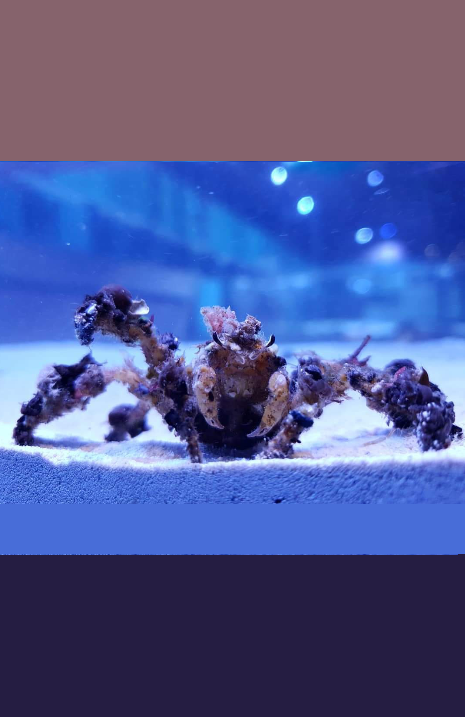🦀Inverts: 🦀All inverts
This page is very large as it contains photos and information on 200-300 species, so it is best viewed on a desktop or laptop, as it may fill several hundred phone screens!
PLEASE NOTE:
This page is part of our old shop pages.
The photos and information on this page may be useful for ID or care information.
As these are old shop pages, I rarely update these pages.
You cannot place orders from this page, please use our new shop pages instead.
To go to our new shop pages to see all our; corals, fish, inverts, and other items, and to place orders, please use the Main menu button.

🦀Inverts - 🦀All inverts

James' highly recommended inverts.
With so many inverts to choose from it can be hard to decide what to get. Here are my recommendations for some of the best, and most popular, invert choices.
James Goodchild, Salty Revolution

Miscellaneous Inverts
Tubeworms
Anemones
Snails & Cowries
Conchs
Shrimps - Pistol & Snapping shrimps
Other shrimps
Hermit crabs - Novelty Hermit crabs
Hermit crabs - Other Hermit crabs
Other crabs
Lobsters & Squat lobsters
Starfish
Urchins
Other Echinoderms
There are more Echinoderms available in our SPECIAL ORDER ITEMS section further down this page.
REFUGIUMS
REFUGIUM ONLY ANIMALS - These are animals that generally are NOT suitable for keeping in most reef tanks!
These animals are best kept in refugiums or sumps. They make excellent clean up crew for areas of your system where food etc may accumulate where your other clean up crew cannot get to it. This helps to keep a system clean, meaning better water parameters for the display too. It also gives you the chance to keep something cool that you can’t keep in your main tank.
REFUGIUM packs
REFUGIUM life

Hermit homes and Goby home packs
What are the benefits of adding seashells to my reef?
Seashells are a vital part of a real coral reef. Hermit crabs aren't the only creatures to live inside them. Many small fish such as small gobies, blennies, and even firefish will use the shell as a home, as will some shrimp species. Shells are also useful as safe breeding spots for Amphipods and Copepods. Some larger creatures such as Jawfish and sand sifting gobies may be too large to fit inside, but, often use them to add strength to their tunnels. Some territorial fish will use shells as boundary markers to mark the edge of their territory. Careful positioning of 1 or 2 larger shells can sometimes stop territory disputes. A trick often used by keepers of Central American Cichlids!

CARE ADVICE - Invertebrates.
WATER QUALITY
All inverts require stable water parameters. Temperature and salinity should be kept as stable as possible, we recommend keeping temperature at 27.5c to 28.5c and salinity at 34.0ppt to 34.5ppt at all times. Many inverts are very sensitive to changes in salinity and should be acclimated by being floated in the tank, with small holes in the bag for a minimum of 4 hours. Inverts should not be exposed to a sudden change in salinity of more than 0.5ppt.
FLOW
Many inverts like medium to strong flow.
FEEDING
We recommend feeding mobile inverts at least once a day. Grazing inverts can be fed seaweed or Vitalis grazing rings. Many inverts enjoy eating frozen Mysis. For filter feeders it is generally not necessary to add additional food for most species, for heavier feeders, or, in tanks with skimmers, feed weekly or daily with liquid coral food. We use Salty Revolution Coral Food 99. This is available here: CLICK HERE. Brightwell (any), Continuum (any), and, ReefRoids, are all also great foods for inverts. Most other brands we have tested have not given very satisfactory results. Ask for advice if you’re unsure whether you need to feed your inverts, and, what to feed them.
SIZE
Inverts vary in size, see care advice above or ask for more information if required. Most inverts are fairly small, and most inverts can b kept in almost unlimited number is tanks of any size. Stocking ratios for most species of as many as 10 inverts per litre (or more) usually cause no issues.
COMPATIBILITY
Some fish may peck at or eat inverts, ensure your fish are compatible with the inverts you want to keep. The fish most likely to cause problems are most Butterflyfish, large Wrasses, and Pufferfish. All our inverts are reef safe, unless stated otherwise. Any inverts that are not reef safe will have large warnings next to their name above saying “NOT REEF SAFE” or “REFUGIUM ONLY”. Unless it specifically says that, then they will be safe in a normal reef aquarium. You may see conflicting advice online regarding how reef safe an invert is. Inverts will climb on corals to clean algae from them, to scavenge from a dead or dying coral, or out of a desperate attempt to prevent death by starvation. Reefkeepers that are losing corals are often happy to blame the inverts for the loss, to make it not their fault the coral died. In reality very few inverts attack corals, and the vast majority of the species we stock do not eat corals as part of their natural diet. We keep a huge variety of species of inverts in with our corals, with no issues at all. Ask for more advice if you are unsure.
UK DELIVERY
We deliver corals, inverts, fish, and, dry goods throughout the UK. You can buy online for pickup in store, or, UK delivery (delivery charge may apply). See the Salty Revolution Shipping Guide for more information on our UK delivery service.rmation on our UK delivery service.

“Some fantastic offers here, such as Rainbow Bubble Tip Anemones from just £19” - James























































































































































































































































